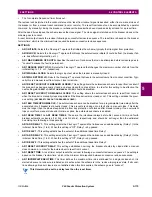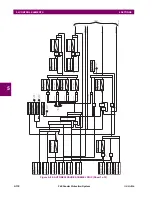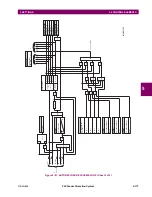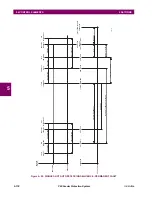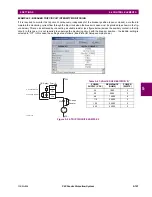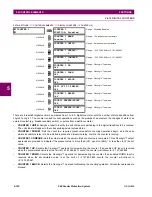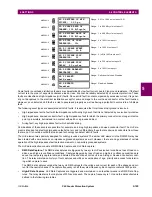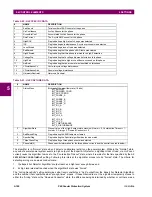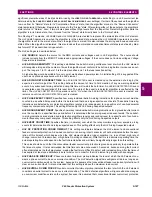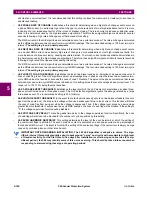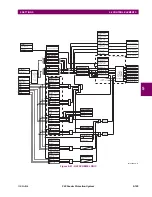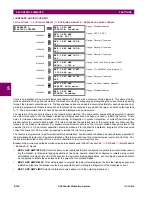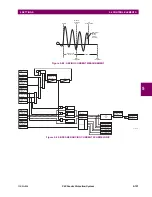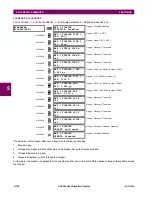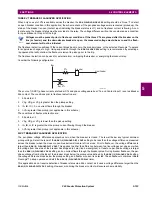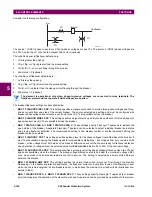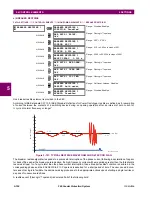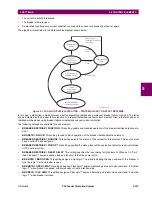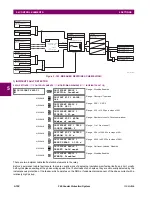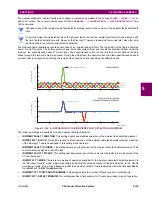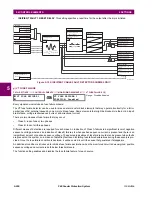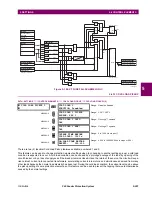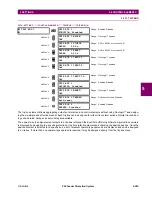
5-188
F60 Feeder Protection System
GE Multilin
5.6 CONTROL ELEMENTS
5 SETTINGS
5
will clear an overcurrent fault. It is recommended that this setting is above the maximum 3Io (residual) current due to
unbalanced loading.
•
HI-Z PHASE RATE OF CHANGE
: Establishes a threshold for determining when a high rate-of-change event occurs on
a phase RMS current. An extremely high rate of change is not characteristic of most high impedance faults; it is more
indicative of a low impedance fault or of the inrush of breaker closing. The inrush current produces substantial varia-
tions in the harmonics used by the high impedance algorithms. Therefore these algorithms ignore all data for several
seconds following a high rate-of-change event that exceeds this setting.
The RMS currents in the Hi-Z algorithms are calculated over a two-cycle time window. The rate-of-change is calculated
as the difference between two consecutive two-cycle RMS readings. The recommended setting is 150 A per two-cycle
interval.
The setting is given in primary amperes
.
•
HI-Z NEUTRAL RATE OF CHANGE
: Establishes a threshold for determining when a high rate-of-change event occurs
on a neutral RMS current. An extremely high rate of change is not characteristic of most high impedance faults; it is
more indicative of a breaker closing, causing associated inrush. The inrush current produces substantial variations in
the harmonics used by the high impedance algorithms. Therefore, these algorithms ignore all data for several seconds
following a high rate-of-change event exceeding this setting.
The RMS currents in the Hi-Z algorithms are calculated over a two-cycle time window. The rate-of-change is calculated
as the difference between two consecutive two-cycle RMS readings. The recommended setting is 150 A per two-cycle
interval.
The setting is given in primary amperes
.
•
HI-Z LOSS OF LOAD THRESHOLD
: Establishes the loss of load level used as an indication of a downed conductor. A
Loss of Load flag is set if the Hi-Z algorithms detect a percentage drop in phase current between two successive two-
cycle RMS values that equals or exceeds the Loss of Load Threshold. The amount the phase current must decrease
between successive two-cycle RMS values is based on this setting times the recent average phase current level. The
range is 5 to 100%; 5% being the most sensitive.
•
HI-Z 3-PHASE EVENT THRESHOLD
: Establishes the level at which the Hi-Z element characterizes a sudden three-
phase current increase as a three-phase event. The Hi-Z detection algorithms ignore the data generated by a large
three-phase event. The recommended setting is 25 A (
primary
).
•
HI-Z VOLTAGE SUPV THRESHOLD
: In the event that a fault simultaneously occurs on two adjacent feeders (line volt-
age from the same bus), the drop in line voltage will cause a subsequent drop in load current. This function will block
the Loss of Load flag from being set while the voltage is depressed. Thus, if the voltage level drops by a percentage
greater than this threshold in successive two-cycle RMS samples, the Loss of Load flag will be blocked. If the setting is
“0”, the voltage supervision function will be disabled.
•
HI-Z VOLTAGE SUPV DELAY
: This setting adds time delay to the voltage supervision function. Specifically, the Loss
of Load flag will continue to be blocked for the number of cycles specified by this setting.
•
HI-Z EVEN HARMONIC RESTRAINT
: This setting determines the level of the even harmonic at which the setting of
the overcurrent flags is inhibited. The even harmonic content is evaluated on each phase current as a percentage of
that phase's RMS current. The intent is to inhibit the setting of the overcurrent flags if the overcurrent is simply a surge
caused by cold-load pickup or other inrush event.
IMPORTANT NOTE REGARDING INSTALLATION: The F60 Hi-Z algorithm is adaptive in nature. The algo-
rithm’s internal thresholds gradually adapt to background “noise” on circuits with a moderate to high level
of transient activity. For the first three to five days after installation (or after being out-of-service for a sig-
nificant period), the F60 may identify some of this noise as arcing. This should be taken into account when
responding to alarms during these type of operating periods.
NOTE
Summary of Contents for F60 UR Series
Page 2: ......
Page 4: ......
Page 30: ...1 20 F60 Feeder Protection System GE Multilin 1 5 USING THE RELAY 1 GETTING STARTED 1 ...
Page 48: ...2 18 F60 Feeder Protection System GE Multilin 2 2 SPECIFICATIONS 2 PRODUCT DESCRIPTION 2 ...
Page 126: ...4 30 F60 Feeder Protection System GE Multilin 4 2 FACEPLATE INTERFACE 4 HUMAN INTERFACES 4 ...
Page 354: ...5 228 F60 Feeder Protection System GE Multilin 5 9 TESTING 5 SETTINGS 5 ...
Page 382: ...6 28 F60 Feeder Protection System GE Multilin 6 5 PRODUCT INFORMATION 6 ACTUAL VALUES 6 ...
Page 398: ...8 8 F60 Feeder Protection System GE Multilin 8 2 FAULT LOCATOR 8 THEORY OF OPERATION 8 ...
Page 414: ...A 14 F60 Feeder Protection System GE Multilin A 1 PARAMETER LIST APPENDIXA A ...
Page 492: ...B 78 F60 Feeder Protection System GE Multilin B 4 MEMORY MAPPING APPENDIXB B ...
Page 530: ...D 10 F60 Feeder Protection System GE Multilin D 1 IEC 60870 5 104 APPENDIXD D ...
Page 542: ...E 12 F60 Feeder Protection System GE Multilin E 2 DNP POINT LISTS APPENDIXE E ...
Page 558: ...x F60 Feeder Protection System GE Multilin INDEX ...


